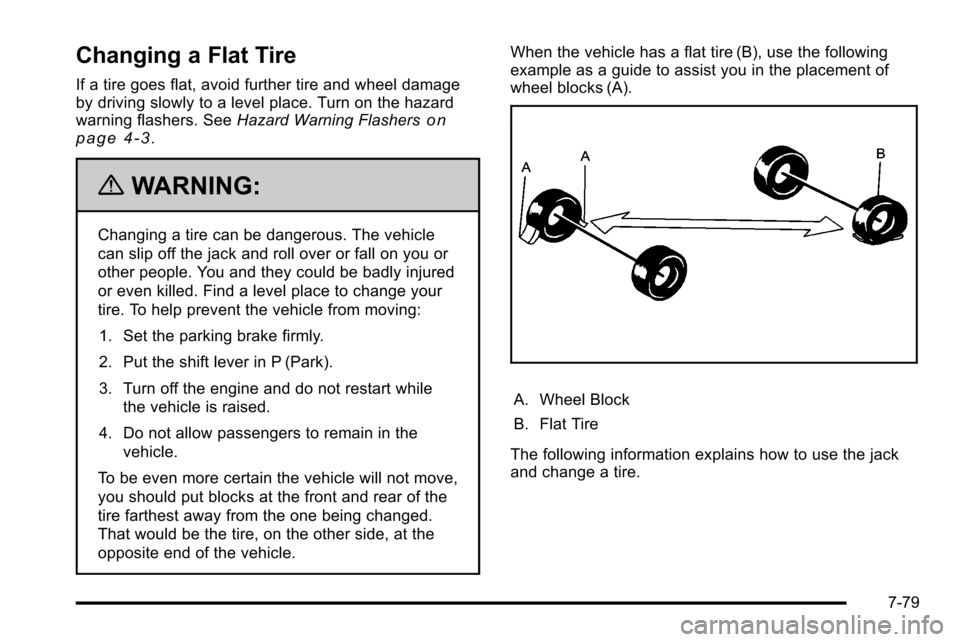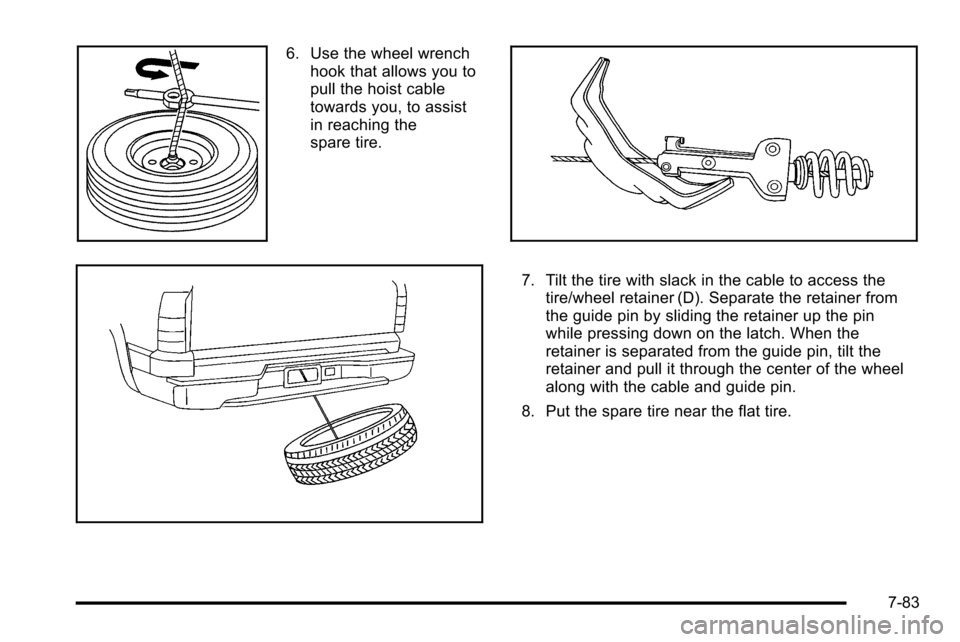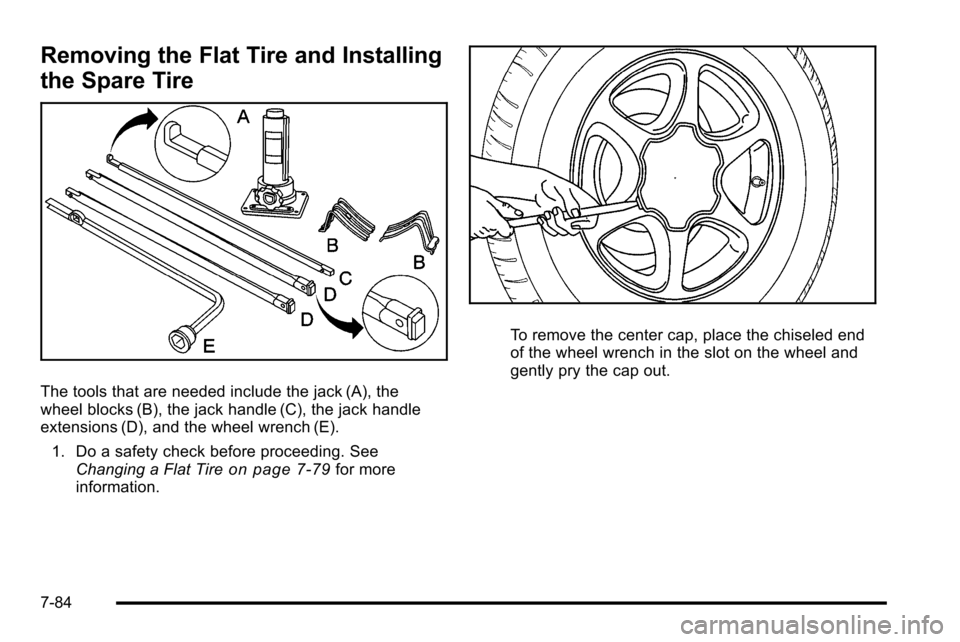CADILLAC ESCALADE EXT 2010 3.G Owners Manual
Manufacturer: CADILLAC, Model Year: 2010, Model line: ESCALADE EXT, Model: CADILLAC ESCALADE EXT 2010 3.GPages: 580, PDF Size: 6.23 MB
Page 491 of 580

Notice:The wrong wheel can also cause problems
with bearing life, brake cooling, speedometer or
odometer calibration, headlamp aim, bumper height,
vehicle ground clearance, and tire or tire chain
clearance to the body and chassis.
See Changing a Flat Tire
on page 7‑79for more
information.
Used Replacement Wheels
{WARNING:
Putting a used wheel on the vehicle is dangerous.
You cannot know how it has been used or how far
it has been driven. It could fail suddenly and
cause a crash. If you have to replace a wheel, use
a new GM original equipment wheel.
Tire Chains
{WARNING:
Do not use tire chains. There is not enough
clearance. Tire chains used on a vehicle without
the proper amount of clearance can cause
damage to the brakes, suspension, or other
vehicle parts. The area damaged by the tire
chains could cause you to lose control of the
vehicle and you or others may be injured in a
crash. Use another type of traction device only if
its manufacturer recommends it for use on the
vehicle and tire size combination and road
conditions. Follow that manufacturer's
instructions. To help avoid damage to the vehicle,
drive slowly, re‐adjust or remove the device if it is
contacting the vehicle, and do not spin the
wheels. If you do find traction devices that will fit,
install them on the rear tires.
7-77
Page 492 of 580

If a Tire Goes Flat
It is unusual for a tire to blowout while you are driving,
especially if you maintain your vehicle's tires properly.
If air goes out of a tire, it is much more likely to leak out
slowly. But if you should ever have a blowout, here are
a few tips about what to expect and what to do:
If a front tire fails, the flat tire creates a drag that pulls
the vehicle toward that side. Take your foot off the
accelerator pedal and grip the steering wheel firmly.
Steer to maintain lane position, and then gently brake to
a stop well out of the traffic lane.
A rear blowout, particularly on a curve, acts much like a
skid and may require the same correction you would
use in a skid. In any rear blowout remove your foot from
the accelerator pedal. Get the vehicle under control by
steering the way you want the vehicle to go. It may be
very bumpy and noisy, but you can still steer. Gently
brake to a stop, well off the road if possible.{WARNING:
Lifting a vehicle and getting under it to do
maintenance or repairs is dangerous without the
appropriate safety equipment and training. If a
jack is provided with the vehicle, it is designed
only for changing a flat tire. If it is used for
anything else, you or others could be badly
injured or killed if the vehicle slips off the jack. If a
jack is provided with the vehicle, only use it for
changing a flat tire.
If a tire goes flat, the next part shows how to use the
jacking equipment to change a flat tire safely.
7-78
Page 493 of 580

Changing a Flat Tire
If a tire goes flat, avoid further tire and wheel damage
by driving slowly to a level place. Turn on the hazard
warning flashers. SeeHazard Warning Flashers
on
page 4‑3.
{WARNING:
Changing a tire can be dangerous. The vehicle
can slip off the jack and roll over or fall on you or
other people. You and they could be badly injured
or even killed. Find a level place to change your
tire. To help prevent the vehicle from moving:
1. Set the parking brake firmly.
2. Put the shift lever in P (Park).
3. Turn off the engine and do not restart while the vehicle is raised.
4. Do not allow passengers to remain in the vehicle.
To be even more certain the vehicle will not move,
you should put blocks at the front and rear of the
tire farthest away from the one being changed.
That would be the tire, on the other side, at the
opposite end of the vehicle. When the vehicle has a flat tire (B), use the following
example as a guide to assist you in the placement of
wheel blocks (A).
A. Wheel Block
B. Flat Tire
The following information explains how to use the jack
and change a tire.
7-79
Page 494 of 580

Removing the Spare Tire and Tools
The jack and the wheel blocks are located under a
cover near the passenger side rear seat.
Rear Seat (Passenger Side) Jack Cover
1. Remove the jack cover by turning the two wing nuts one-quarter turn counterclockwise and pulling
the jack cover off.
A. Wheel Blocks
B. Jack Knob
C. Wing Nut D. Retaining Hook
E. Jack
F. Mounting Bracket
2. Release the jack (E) from the mounting bracket (F) by turning the jack knob (B) on the jack
counterclockwise to release the jack from the
mounting bracket.
7-80
Page 495 of 580

3. Remove the wheel blocks (A) attachedto the jack (E) by turning the wing nut (C)
counterclockwise. Place the wheel blocks where
needed as indicated in previously in this section.
The tools for changing a flat tire are located in the
passenger's side top-box storage unit.
To remove the tools, do the following: 1. Open the top door on the passenger's side top-box storage unit. Use the ignition/door key to unlock it if
it is locked. See Top-Box Storage
on page 3‑76for more information.
2. Remove the black pouch from the storage box. You now have all of the tools you will need to lower
the spare tire and change a flat. To access the spare tire:
A. Spare Tire (Valve
Stem Pointed Down)
B. Hoist Assembly
C. Hoist Cable
D. Tire/Wheel Retainer E. Hoist Shaft
F. Hoist End of Extension Tool G. Hoist Shaft
Access Hole
H. Wheel Wrench I. Jack Handle Extension(s)
J. Spare Tire Lock
7-81
Page 496 of 580

1. Open the hoist shaft access cover on the bumperto access the spare tire lock (J).
2. To remove the spare tire lock, insert the ignition key, turn it clockwise and pull it straight out.
3. Assemble the two jack handle extensions (I) andwheel wrench (H) as shown.
4. Insert the open end ofthe extension (F)
through the hole in the
rear bumper (G) (hoist
shaft access hole).
Be sure the hoist end (F) of the extension connects
to the hoist shaft (E). The ribbed square end of the
extension is used to lower the spare tire.
Do not use the chiseled end of the wheel wrench.
5. Turn the wheel wrench counterclockwise to lower the spare tire to the ground. Continue to turn the
wheel wrench until the spare tire can be pulled out
from under the vehicle.
If the spare tire does not lower to the ground, the
secondary latch is engaged causing the tire not to
lower. See Secondary Latch System
on page 7‑89for more information.
7-82
Page 497 of 580

6. Use the wheel wrenchhook that allows you to
pull the hoist cable
towards you, to assist
in reaching the
spare tire.
7. Tilt the tire with slack in the cable to access thetire/wheel retainer (D). Separate the retainer from
the guide pin by sliding the retainer up the pin
while pressing down on the latch. When the
retainer is separated from the guide pin, tilt the
retainer and pull it through the center of the wheel
along with the cable and guide pin.
8. Put the spare tire near the flat tire.
7-83
Page 498 of 580

Removing the Flat Tire and Installing
the Spare Tire
The tools that are needed include the jack (A), the
wheel blocks (B), the jack handle (C), the jack handle
extensions (D), and the wheel wrench (E).1. Do a safety check before proceeding. See Changing a Flat Tire
on page 7‑79for more
information.
To remove the center cap, place the chiseled end
of the wheel wrench in the slot on the wheel and
gently pry the cap out.
7-84
Page 499 of 580

3. Use the wheelwrench to loosen all
the wheel nuts. Turn
the wheel wrench
counterclockwise to
loosen the wheel nuts.
Do not remove the
wheel nuts yet.
Jacking Locations (Overall View)
A. Front Position
B. Rear Position
{WARNING:
Getting under a vehicle when it is jacked up is
dangerous. If the vehicle slips off the jack, you
could be badly injured or killed. Never get under a
vehicle when it is supported only by a jack.
{WARNING:
Raising your vehicle with the jack improperly
positioned can damage the vehicle and even
make the vehicle fall. To help avoid personal
injury and vehicle damage, be sure to fit the jack
lift head into the proper location before raising the
vehicle.
4. Position the jack under the vehicle as shown.
7-85
Page 500 of 580

Front Position
Front Tire Flat: If the flat tire is on a front tire
of the vehicle, you will need to use the jack
handle (B) and only one jack handle extension (C).
Attach the wheel wrench (D) to the jack handle
extension (C). Attach the jack handle (B) to the
jack (A). Position the jack on the frame behind the
flat tire near the front body mount (E) as shown.
Turn the wheel wrench (D) clockwise to raise the
vehicle. Raise the vehicle far enough off the
ground so there is enough room for the spare tire
to clear the ground.Rear Position
Rear Tire Flat: If the flat tire is on a rear tire of
the vehicle, use the jack handle (B) and both
jack handle extensions (C). Attach the wheel
wrench (D) to the jack handle extensions (C).
Attach the jack handle (B) to the jack (A). Use the
jacking pad (E) provided on the rear axle. Turn the
wheel wrench (D) clockwise to raise the vehicle.
Raise the vehicle far enough off the ground so
there is enough room for the spare tire to clear the
ground.
7-86